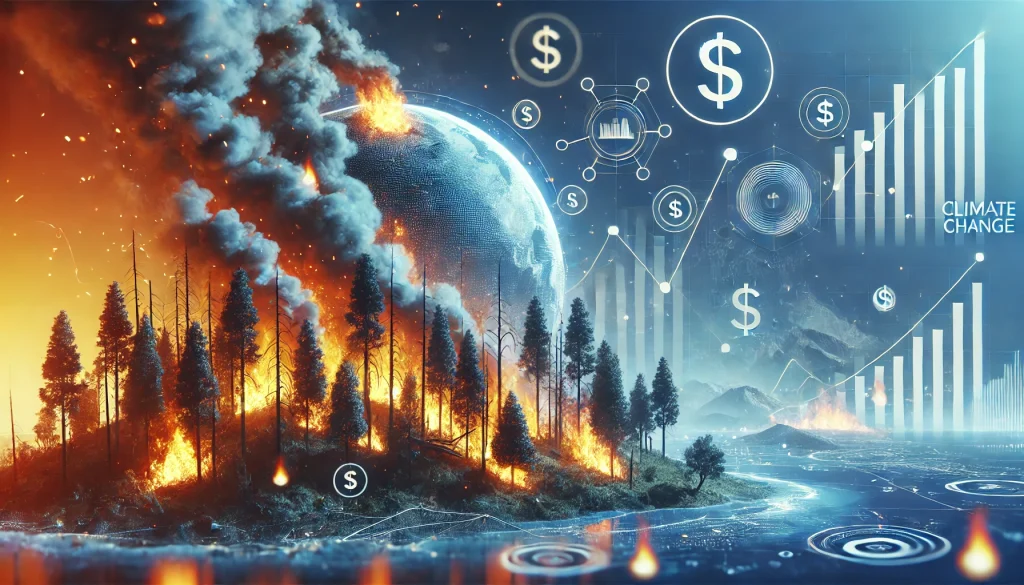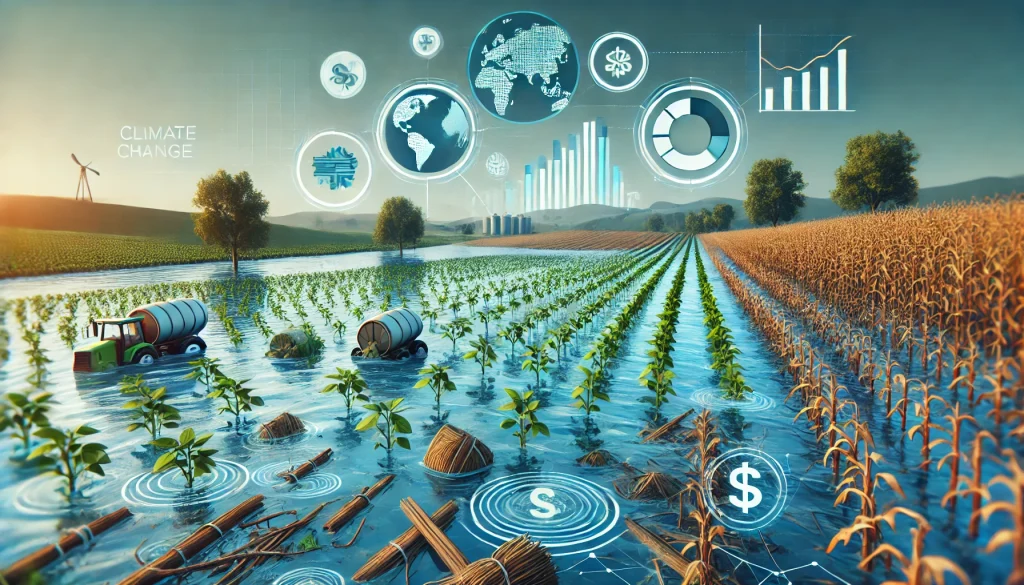
Climate change isn’t just an environmental issue—it’s also an economic one. The financial impact of climate change is becoming more evident as it affects industries, economies, and livelihoods worldwide. From rising costs in agriculture to the strain on infrastructure, understanding how climate change impacts global economies is crucial for businesses, governments, and individuals. This review will explore the economic consequences, key sectors affected, and what’s being done to mitigate these effects.
Overview of the Economic Impact of Climate Change
Climate change refers to long-term changes in global temperature, weather patterns, and sea levels. Economically, it impacts industries and governments by increasing costs, causing resource scarcity, and leading to lost productivity. Terms like “climate economics” and “environmental economics” describe this focus on how environmental changes impact the economy. The financial consequences range from direct costs like infrastructure repairs after extreme weather events to indirect costs, such as migration and health care expenses.
Key Areas Affected by Climate Change

- Agriculture: Reduced crop yields threaten food security and increase prices.
- Infrastructure: Damage from floods, hurricanes, and wildfires is on the rise.
- Health Costs: Climate change is linked to the spread of diseases like malaria, causing health care costs to skyrocket.
- Energy Supply: The demand for renewable energy grows, increasing costs for consumers and businesses.
- Insurance: Insurance premiums for climate-related disasters are increasing as risks become harder to predict.
Historical Context and Evolution of Climate Economics
Economists began studying climate change’s economic impact in the 1990s, with the Kyoto Protocol marking the first international effort to address emissions. Since then, policies like the Paris Agreement have shifted focus to reducing carbon footprints and promoting sustainable development.
| Year | Event | Significance |
|---|---|---|
| 1997 | Kyoto Protocol | First international recognition of the economic cost of emissions. |
| 2015 | Paris Agreement | Shift towards global economic policies focused on sustainability. |
Economic Costs of Climate Change

The economic costs of climate change are immense, both in direct and indirect ways. Direct costs refer to the immediate financial impacts resulting from climate-related disasters. For example, hurricanes, floods, and wildfires destroy homes, businesses, and infrastructure. Governments and local authorities are forced to spend billions on rebuilding efforts. The U.S., for instance, spent over $165 billion on recovery from hurricanes alone in 2022. These events also disrupt transportation, energy supplies, and communication networks, adding to the overall financial burden.
Indirect costs involve longer-term impacts, such as reduced worker productivity due to health issues caused by increased temperatures and the spread of climate-related diseases like malaria. Another significant cost arises from climate migration. As rising sea levels, droughts, and other environmental changes make certain regions uninhabitable, people are forced to relocate, which places financial strain on cities and countries that must accommodate these displaced populations. Furthermore, businesses may face losses in profitability as extreme weather affects supply chains, disrupts production, and increases the cost of materials. In regions heavily reliant on agriculture or tourism, such as coastal cities, these indirect costs can severely damage the local economy.
Economic Benefits of Mitigating Climate Change
Investing in climate change mitigation can benefit economies by creating jobs and reducing long-term costs.
- Job Creation: The renewable energy sector is growing, providing jobs in solar and wind industries.
- Energy Efficiency: Businesses can save on energy costs through sustainability initiatives.
- Improved Public Health: Reducing pollution can lower healthcare expenses by reducing disease rates.
Policy Implications and Economic Strategies for Climate Change
Governments around the world are integrating climate change into their economic policies, shifting toward more sustainable practices. Carbon taxes, which place a price on greenhouse gas emissions, are increasingly being used to incentivize reductions in pollution. International agreements like the Paris Agreement encourage countries to set emission reduction targets, influencing national policies. Investments in renewable energy, like wind and solar, are expanding as governments subsidize green technology. Strategies like the Green New Deal focus on overhauling economies by building sustainable infrastructure, creating jobs, and reducing dependence on fossil fuels.
Real-World Case Studies: Economic Impact of Climate Change
California (USA)
California’s economy has been hit hard by wildfires, droughts, and extreme heat in recent years. Wildfires have caused billions of dollars in property damage, leading to increased insurance premiums and making it difficult for homeowners to rebuild. In 2020 alone, California faced over $10 billion in wildfire-related damages. The agricultural sector, which relies heavily on water for irrigation, has also suffered due to persistent droughts. Crop failures and reduced yields have increased food prices, and water scarcity has forced farmers to reduce their production, leading to a loss in jobs and revenue.
Bangladesh
Bangladesh is one of the most vulnerable countries to the impacts of climate change. Flooding caused by rising sea levels and increasingly intense storms has displaced millions of people. The agricultural sector, which forms a significant part of Bangladesh’s economy, has experienced devastating losses, with crops frequently wiped out by floods. The country is also experiencing economic strain as it tries to invest in flood defense systems, relocation efforts, and climate adaptation measures. The costs of these efforts are overwhelming, especially for a developing nation, and international aid has been necessary to help alleviate the financial burden.
Australia
Australia is no stranger to the economic consequences of climate change. The bushfires that ravaged the country in 2019 and 2020 destroyed homes, businesses, and vast areas of farmland. The tourism sector, which accounts for a significant portion of Australia’s GDP, suffered immensely as bushfires affected popular tourist destinations. Losses in the tourism industry alone amounted to over $4.5 billion. In addition to tourism, agriculture was severely impacted as livestock and crops were lost to the fires. The long-term economic effects include rebuilding efforts and developing strategies to prevent future fire damage, all of which require substantial investment.
The Future Economic Outlook on Climate Change
The future economic outlook is shaped by how quickly nations adapt to climate-conscious policies. Economies will likely shift towards greener technologies and sustainable practices to minimize long-term damage. Renewable energy industries, such as solar and wind, are expected to grow, leading to new job creation and investment opportunities. However, delays in addressing climate change will worsen economic inequalities, especially in developing nations. Overall, the transition to a low-carbon economy will require global cooperation and significant financial investments to manage risks and minimize future costs.
FAQ
How does climate change affect global economies?
Climate change increases costs for governments and industries through natural disasters, health care, and productivity loss.
What are the economic benefits of addressing climate change?
Mitigating climate change creates jobs, improves public health, and leads to long-term energy savings for businesses and governments.
Which economies are most vulnerable to climate change?
Developing countries and coastal regions, such as Bangladesh and parts of the U.S., face significant economic risks from rising sea levels, extreme weather, and loss of agriculture.
Resources
- Climate School (Columbia University). How Climate Change Affects the Economy
- World Economic Forum. Climate Crisis Costing Global Economies
- Nature. Study on Economic Impact of Climate Change
- Harvard Magazine. Economic Impacts of Climate Change
- The New York Times. How Climate Change is Affecting the Economy
